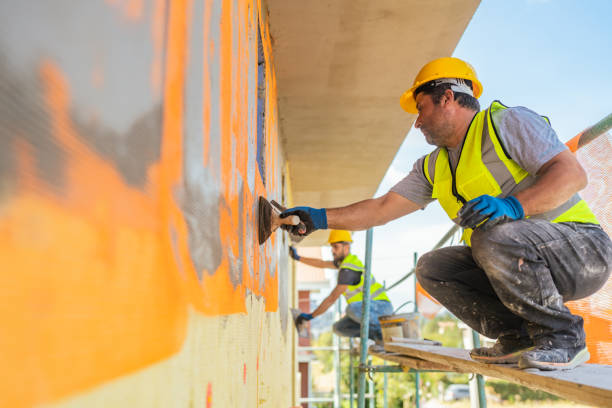
In Scottsdale, Arizona, cinder block walls are common for fences, property dividers, and exterior building features. While they offer strength and low maintenance, they often lack aesthetic appeal. Applying stucco over cinder block not only enhances the appearance but also increases the wall’s durability, UV resistance, and weather protection. Whether you’re upgrading a garden wall or improving your home’s exterior, properly stuccoing cinder block is a smart investment in Scottsdale’s harsh climate.
Here’s how to achieve a beautiful, long-lasting stucco finish that stands up to the Arizona sun and seasonal monsoon rains.
Key Takeaways
Stucco improves the look and lifespan of cinder block walls in Scottsdale’s intense climate.
Surface preparation is critical for adhesion and durability.
Using a three-coat stucco system ensures the strongest, longest-lasting results.
Professional application helps match textures and prevent cracking.
Why Stucco Cinder Block Walls?
Stucco offers multiple advantages for cinder block structures:
Aesthetic Appeal: Smooth or textured finishes create a polished, architectural look.
Weather Resistance: Properly sealed stucco protects against moisture and UV degradation.
Low Maintenance: Once applied, stucco requires minimal upkeep compared to exposed concrete block.
Customizable Color: Through integral coloring or fog coating, you can achieve almost any shade to match your Scottsdale home’s style.
If you’ve recently done stucco repairs elsewhere on your property, extending a similar look to cinder block walls ensures visual consistency.
Materials You’ll Need
Masonry bonding agent
Pre-mixed or traditional stucco mix
Metal lath (optional, depending on wall condition)
Scratch coat and brown coat materials
Hawk, trowel, and float tools
Sponge, brush, and buckets for cleaning
Protective sealant (for finished surface)
Step-by-Step: How to Stucco a Cinder Block Wall
1. Inspect and Prepare the Wall
Clean the block wall thoroughly to remove dust, efflorescence, or loose particles. Use a wire brush and hose if needed. Check for cracks or loose blocks and repair them before stuccoing.
If the cinder block is very smooth or painted, you may need to roughen the surface with a grinder or apply a bonding agent to improve adhesion.
2. Apply Bonding Agent (If Needed)
For walls without enough texture for stucco to grip, apply a masonry bonding agent. Follow manufacturer instructions carefully. This step ensures that the stucco adheres tightly and doesn’t delaminate over time.
3. Apply the Scratch Coat
Mix the stucco according to package directions or traditional recipes. Using a trowel, apply the first “scratch” coat about 3/8-inch thick. Score horizontal lines across the wet coat using a scarifier tool or a notched trowel. Let this coat cure for 24–48 hours, misting occasionally to prevent it from drying too quickly in Scottsdale’s dry heat.
4. Apply the Brown Coat
After the scratch coat has cured, apply the brown coat about 3/8-inch thick. Smooth it out to create an even surface. This layer further strengthens the wall and prepares it for the decorative finish. Let the brown coat cure for several days, misting daily to promote slow, strong drying.
5. Apply the Finish Coat
Mix your finish coat and apply it with a trowel or spray machine, depending on the desired texture. In Scottsdale, homeowners often choose smooth, Spanish lace, or sand finishes to complement the local architecture.
If coloring the stucco, use an integral color mix or plan to apply a breathable fog coat afterward for a fresh, vibrant look.
6. Seal the Surface (Optional but Recommended)
After the finish coat has fully cured, apply a breathable masonry sealer to enhance weather resistance and extend the life of your stuccoed wall.
Common Mistakes to Avoid
Skipping Surface Prep: Failing to clean or bond the wall properly leads to poor adhesion.
Applying Too Thickly: Overly thick coats can crack as they dry. Stick to proper thickness guidelines.
Drying Too Fast: In Scottsdale’s climate, mist the stucco lightly during curing to prevent surface cracking from rapid drying.
Poor Weather Timing: Avoid applying stucco in extreme heat or windy conditions, which can lead to weak finishes.
Professional vs. DIY: Which is Best?
Small sections can be tackled DIY if you have masonry experience and the right tools. However, for large walls, multi-texture matching, or if you need seamless integration with your home’s existing finish, hiring professionals is your safest bet.
Stucco Contractors Arizona has deep experience handling Scottsdale’s unique stucco challenges, ensuring durable, beautiful results whether you’re updating walls, fences, or home exteriors.
Give Your Cinder Block Walls a Stunning Upgrade
Transform your plain cinder block walls into stunning architectural features with the right stucco technique. A well-applied stucco finish not only beautifies but also protects your property for years to come—standing strong against the Arizona sun, storms, and shifting temperatures.
Ready to give your walls a professional makeover? Contact Stucco Contractors Arizona today for expert stucco services in Scottsdale and beyond!
